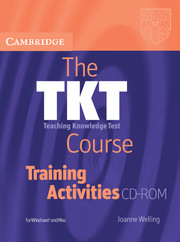3.5 - Group dynamics
Published online by Cambridge University Press: 09 February 2024
Summary
Instructions
1. Divide trainees into pairs. Hand out one worksheet to each pair. Ask trainees to identify the six different interaction patterns in A on the worksheet.
2. Lead feedback, and write the six different interaction patterns on the board as below:
(If your trainees are more familiar with variations on these symbols, you may substitute as necessary.)
3. Refer the pairs to the table in B on the worksheet. Ask trainees to decide for each one which interaction pattern they would use. Stress that several different interaction patterns are possible, and that there is no single correct answer.
4. As each pair finishes, join them with another pair to form a group of four. Ask each pair to compare their choice of interaction patterns with the other pair in their group. For each answer that they can successfully justify, a pair receives one point. In each group the pair with the most points wins. Monitor and act as referee where necessary.
5. Lead whole-class feedback by asking what factors influenced trainees’ choice of interaction pattern. Ensure that the following factors are discussed:
• Your teaching aims: main, subsidiary and personal aims
• The activity: whether controlled practice, discussion or project work, the activity will lend itself to one or two different interaction patterns
• Variety of interaction (balance): within one lesson, over a sequence of lessons
• Class size: prohibitively large or small, space available
• Students’ learning styles: group learners and individual learners
• Students’ abilities and level: stronger and weaker students working together or apart
• Students’ personalities: whether shy or dominant
• Group dynamics: the behaviour, relationship and interaction between students
• Learners’ previous experience: patterns they are used to
Variation
Elicit the factors which affect choice of interaction pattern before the trainees make their own choices in stage 5.
- Type
- Chapter
- Information
- The TKT Course Training Activities , pp. 76 - 77Publisher: Cambridge University PressFirst published in: 2024

